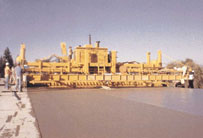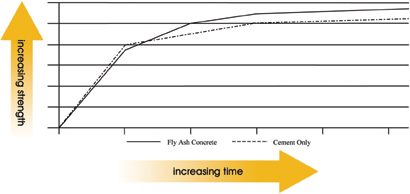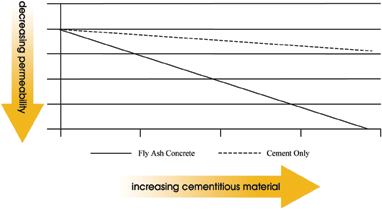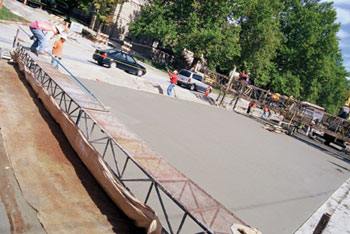Fly Ash Facts for Highway Engineers
Chapter 3 - Fly Ash in Portland Cement Concrete
- Introduction
- Mix Design and Specification Requirements
- Fly Ash Properties
- Other Constituents
- Construction Practices
Introduction
The use of fly ash in portland cement concrete (PCC) has many benefits and improves concrete performance in both the fresh and hardened state. Fly ash use in concrete improves the workability of plastic concrete, and the strength and durability of hardened concrete. Fly ash use is also cost effective. When fly ash is added to concrete, the amount of portland cement may be reduced.
Benefits to Fresh Concrete. Generally, fly ash benefits fresh concrete by reducing the mixing water requirement and improving the paste flow behavior. The resulting benefits are as follows:
- Improved workability. The spherical shaped particles of fly ash act as miniature ball bearings within the concrete mix, thus providing a lubricant effect. This same effect also improves concrete pumpability by reducing frictional losses during the pumping process and flat work finishability.
Figure 3-1: Fly ash improves workability for pavement concrete.

Decreased water demand. The replacement of cement by fly ash reduces the water demand for a given slump. When fly ash is used at about 20 percent of the total cementitious, water demand is reduced by approximately 10 percent. Higher fly ash contents will yield higher water reductions. The decreased water demand has little or no effect on drying shrinkage/cracking. Some fly ash is known to reduce drying shrinkage in certain situations.
Reduced heat of hydration. Replacing cement with the same amount of fly ash can reduce the heat of hydration of concrete. This reduction in the heat of hydration does not sacrifice long-term strength gain or durability. The reduced heat of hydration lessens heat rise problems in mass concrete placements.
Benefits to Hardened Concrete. One of the primary benefits of fly ash is its reaction with available lime and alkali in concrete, producing additional cementitious compounds. The following equations illustrate the pozzolanic reaction of fly ash with lime to produce additional calcium silicate hydrate (C-S-H) binder:
| (hydration) | ||
| Cement Reaction: | C3S + | H → C-S-H + CaOH |
| Pozzolanic Reaction: | CaOH + | S → C-S-H |
| silica from ash constituents | ||
- Increased ultimate strength. The additional binder produced by the fly ash reaction with available lime allows fly ash concrete to continue to gain strength over time. Mixtures designed to produce equivalent strength at early ages (less than 90 days) will ultimately exceed the strength of straight cement concrete mixes (see Figure 3-2).
Figure 3-2: Typical strength gain of fly ash concrete.

- Reduced permeability. The decrease in water content combined with the production of additional cementitious compounds reduces the pore interconnectivity of concrete, thus decreasing permeability. The reduced permeability results in improved long-term durability and resistance to various forms of deterioration (see Figure 3-3)
Figure 3-3: Permeability of fly ash concrete.

- Improved durability. The decrease in free lime and the resulting increase in cementitious compounds, combined with the reduction in permeability enhance concrete durability. This affords several benefits:
- Improved resistance to ASR. Fly ash reacts with available alkali in the concrete, which makes them less available to react with certain silica minerals contained in the aggregates.
- Improved resistance to sulfate attack. Fly ash induces three phenomena that improve sulfate resistance:
- Fly ash consumes the free lime making it unavailable to react with sulfate
- The reduced permeability prevents sulfate penetration into the concrete
- Replacement of cement reduces the amount of reactive aluminates available
- Improved resistance to corrosion. The reduction in permeability increases the resistance to corrosion.
Figure 3-4: Fly ash concrete is used in severe exposure applications
such as the decks and piers of Tampa Bay's Sunshine Skyway Bridge.
Mix Design and Specification Requirements
Procedures for proportioning fly ash concrete (FAC) mixes necessarily differ slightly from those for conventional PCC. Basic guidelines for selecting concrete proportions are contained in the American Concrete Institute (ACI) Manual of Concrete Practice, Section 211.1. Highway agencies generally use variations to this procedure, but the basic concepts recommended by ACI are widely acknowledged and accepted. There is very little on proportioning in ACI 232.2.
Fly ash is used to lower the cost and to improve the performance of PCC. Typically, 15 percent to 30 percent of the portland cement is replaced with fly ash, with even higher percentages used for mass concrete placements. An equivalent or greater weight of fly ash is substituted for the cement removed. The substitution ratio for fly ash to portland cement is typically 1:1 to 1.5:1.
A mix design should be evaluated with varying percentages of fly ash. Time versus strength curves can be plotted for each condition. To meet specification requirements, curves are developed for various replacement ratios and the optimum replacement percentage ratio is selected. A mix design should be performed using the proposed construction materials. It is recommended that the fly ash concrete being tested incorporates local materials in performance evaluation.
Cement Factors. Because fly ash addition contributes to the total cementitious material available in a mix, the minimum cement factor (portland cement) used in the PCC can be effectively reduced for FAC. The ACI acknowledges this contribution and recommends that a water/ (cement plus pozzolan) ratio be used for FAC in lieu of the conventional water/cement ratio used in PCC.
Fly ash particles react with free lime in the cement matrix to produce additional cementitious material, and thus, to increase long-term strength.
Fly Ash Properties
Fineness. The fineness of fly ash is important because it affects the rate of pozzolanic activity and the workability of the concrete. Specifications require a minimum of 66 percent passing the 0.044 mm (No. 325) sieve.
Specific gravity. Although specific gravity does not directly affect concrete quality, it has value in identifying changes in other fly ash characteristics. It should be checked regularly as a quality control measure, and correlated to other characteristics of fly ash that may be fluctuating.
Chemical composition. The reactive aluminosilicate and calcium aluminosilicate components of fly ash are routinely represented in their oxide nomenclatures such as silicon dioxide, aluminum oxide and calcium oxide. The variability of the chemical composition is checked regularly as a quality control measure. The aluminosilicate components react with calcium hydroxide to produce additional cementitious materials. Fly ashes tend to contribute to concrete strength at a faster rate when these components are present in finer fractions of the fly ash.
Sulfur trioxide content is limited to five percent, as greater amounts have been shown to increase mortar bar expansion.
Available alkalis in most ashes are less than the specification limit of 1.5 percent. Contents greater than this may contribute to alkali-aggregate expansion problems.
Carbon content. LOI is a measurement of unburned carbon remaining in the ash. It can range up to five percent per AASHTO and six percent per ASTM. The unburned carbon can absorb air entraining admixtures (AEAs) and increase water requirements. Also, some of the carbon in fly ash may be encapsulated in glass or otherwise be less active and, therefore, not affect the mix. Conversely, some fly ash with low LOI values may have a type of carbon with a very high surface area, which will increase the AEA dosages. Variations in LOI can contribute to fluctuations in air content and call for more careful field monitoring of entrained air in the concrete. Further, if the fly ash has a very high carbon content, the carbon particles may float to the top during the concrete finishing process and may produce dark-colored surface streaks.
Other Constituents
Aggregates. As with any concrete mix, appropriate sampling and testing are needed to ensure that the aggregates used in the mix design are of good quality and are representative of the materials that will be used on the project. Aggregates containing reactive silica may be used in the FAC.
Cement. Fly ash can be used effectively in combination with all types of cements: portland cement, performance cement, and blended cements. However, special care should be taken when using fly ash with high early strength or pozzolanic cements. Appropriate mix design and testing should be conducted to evaluate the impact of fly ash addition on the performance of high early strength concrete. Blended or pozzolanic cements already contain fly ash or other pozzolan. Additional cement replacement would affect early strength development. Characteristics of cement vary, as do fly ashes, and not all combinations produce a good concrete. The selected portland cement should be tested and approved on its own merit, as well as evaluated in combination with the specific fly ash to be used.
Air Entraining Admixtures (AEAs). The higher the carbon content in the fly ash, the more difficult it is to control the air content. Further, if the carbon content varies, air content must be closely monitored and admixture dosage rates changed to insure proper levels of air entrainment.
Retarders. Adding fly ash should not appreciably alter the effectiveness of a chemical retarder. Some fly ashes may delay the time of set and may reduce the need for a retarder.
Water reducers. Fly ash concrete normally requires less water, but it can be further improved with the use of a water-reducing admixture. The effectiveness of these admixtures can vary with the addition of fly ash.
Construction Practices
Fly ash concrete mixes can be developed to perform essentially the same as PCC mixes with minor differences. When mixing and placing any FAC, some minor changes in field operation may be desirable. The following general rules-of-thumb will be useful:
Plant Operations. Fly ash requires a separate watertight, sealed silo or holding bin for storage. Take care and clearly mark the loading pipe for fly ash to guard against cross-contamination when deliveries are made. If a separate holding bin cannot be provided, it may be possible to divide the cement silo. If available, use a double-walled divider to prevent cross-contamination. Due to its particle spherical shape, dry fly ash is more flowable than dry portland cement. The angle of repose of fly ash is typically less than that of cement.
As with any concrete mix, mixing time and conditions are critical to producing quality concrete. The increase in paste volume and concrete workability (ball bearings effect) associated with the use of fly ash typically improve mixing efficiency.
Field Practices. Beginning with the first concrete delivery to the job site, every load should be checked for entrained air until the project personnel are confident a consistent air content is being obtained. After that, periodic testing should continue to ensure consistency. Concrete should be placed as quickly as possible to minimize entrained air loss by extended agitation. Normal practices for consolidation should be followed. Excessive vibration should be avoided to minimize the loss of in-place air content.
FAC mix workability characteristics allow it to be placed easily. Many contractors report improved smoothness of FAC pavements over those constructed with conventional PCC. FAC contains more paste than conventional PCC, which is beneficial to the finishing. The slower early strength development of FAC may also result in longer moisture retention.
Figure 3-5: Fly ash concrete finishing

Troubleshooting. First-time users of fly ash in concrete should evaluate the performance of proposed mixes prior to construction. All concrete ingredients must be tested and evaluated to develop the desired mix design.
Air content. The fineness of fly ash and the improved workability of FAC make it naturally more difficult to develop and hold entrained air. Also, residual unburned carbon in ash adsorbs some of the air entraining agent and make it more challenging to develop the desired air content. Higher carbon content ashes naturally require higher AEA contents. Quality assurance and quality control testing of ash at the source must ensure that the fly ash used maintains a uniform carbon content (LOI) to prevent unacceptable fluctuations in entrained air. New technologies and procedures to address unburned carbon in fly ash are described in Chapter 10.
Lower early strength. Fly ash concrete mixes typically result in lower strengths at early ages. The slower strength gain may require forms to be strengthened to mitigate hydraulic loads. It should be noted that form removal and opening to traffic may be delayed due to the slower strength gains. Lower early strengths can be overcome by using accelerators.
Seasonal limitations. Construction scheduling should allow time for FAC to gain adequate density and strength to resist de-icing applications and freeze-thaw cycling prior to the winter months. Strength gain of FAC is minimal during the colder months. Although pozzolanic reactions are significantly diminished below 4.4 degrees C (40 degrees F), strength gain may continue at a slower rate resulting from continued cement hydration. Chemical admixtures can be utilized to off-set seasonal limitations.

